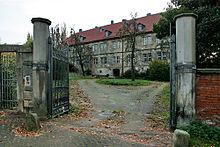Office of Koldingen
The Koldingen office was a historical administrative area of the Principality of Calenberg and the Kingdom of Hanover with its seat in Koldingen .
history
The castle Koldingen was in the 13th or 14th century by the Counts of Hallermund built, fell in the 14th century to the Bishopric of Hildesheim and was in the course of territorialisation the center of an office that mainly the right of the line extended. In the Quedlinburg Recess the office came back to the Welfs (Principality of Calenberg) in 1523 and was merged with the Ruthe office . Since then, the term Haus Lauenburg has been used for Koldingen Castle and Lauenburg for the combined office . After the Thirty Years' War it was replaced by the name Amt Koldingen .
Duke Heinrich Julius von Braunschweig-Wolfenbüttel had Koldingen Castle built around 1590 as the new administrative center for the castle buildings. Due to the Edict of Restitution of 1629, the administration was temporarily carried out again by officials from Hildesheim. When the large monastery was finally returned to the duchy of Hildesheim in 1643, Koldingen and Ruthe were separated. The original Koldingen office remained Welfisch and was restored as such and increased by the greater part of Goe Pattensen from the Calenberg office until 1653 : Hiddestorf, Ihme, Roloven, Linderte, Ohlendorf and Vörie came to Koldingen in 1643, Devese, Harkenbleck, Hemmingen in 1648 and Wilkenburg, finally speeches in 1653. Most recently, the Amt of Koldingen was expanded in 1671 to include the so -called Kleine Freie ( Döhren , Wülfel , Laatzen ), which had previously belonged to the Principality of Lüneburg . The three villages formed their own bailiwick within the office. The boundary between the offices of Koldingen and Ruthe was only finally determined by a comparison around 1750.
In 1824 the Koldingen Office was combined with the Hanover Court School Administration to form the new Hanover Office .
scope
When it was abolished (1824) the office comprised the following municipalities:
Bailiffs
- around 1521: Christoph v. Czene, Drost
- around 1539: Johann Hartlef, bailiff
- approx. 1545 - after 1559: Balthasar Hülsing, bailiff
- 1590-: Johann Kaufmann, bailiff
- around 1650: Conrad Block, bailiff
...
- before 1808: Flügge
- 1818–1821: Johann Georg Meyer, bailiff
- 1822–1824: Georg Ludwig von Lüpke, bailiff
Official mills
Two stately mills were under the administration of the office, an undershot river mill on the Alte Leine and the smaller overshot pond mill on the Pattenser Schille. Both are mentioned in the inheritance register of 1593. The river mill was badly damaged by a flood in 1587 and abandoned, instead the pond mill was renewed and enlarged in 1595. It was operated as a lease mill until the 1940s. The mill house has been preserved.
literature
- Hans Goedeke: Hereditary register of the offices of Ruthe and Koldingen from 1593 (= publications of the Historical Commission for Lower Saxony and Bremen 24), Hildesheim 1973
- Iselin Gundermann , Walther Hubatsch : Outline of the German administrative history 1815-1945 . Row A: Prussia, Volume 10: Hanover. Marburg (Lahn) 1981
- Manfred Hamann : Overview of the holdings of the Lower Saxony Main State Archives in Hanover. Third volume: Central and subordinate authorities in the Landdrostei and administrative districts of Hanover, Hildesheim and Lüneburg until 1945. Göttingen 1983, p. 285.
Individual evidence
- ↑ Helmut Flohr: Right and left of the leash. Searching for traces in the Leinemasch between Döhren and Koldingen , Laatzen-Grasdorf 2012, p. 62 f.
